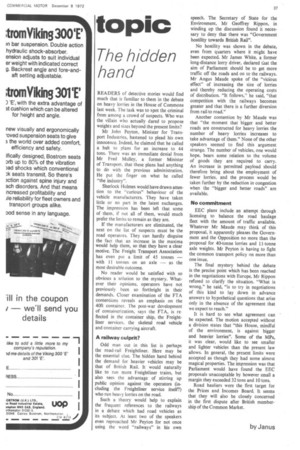topic
Page 39

If you've noticed an error in this article please click here to report it so we can fix it.
The hidden hand
READERS of detective stories would find much that is familiar to them in the debate on heavy lorries in the House of Commons last week. The task was to spot the criminal from among a crowd of suspects. Who was the villain who actually dared to propose weights and sizes beyond the present limits?
Mr John Peyton, Minister for Transport Industries, hastened to plead his own innocence. Indeed, he claimed that he called a halt to plans for an increase to 44 tons. There was an immediate denial from Mr Fred Mulley, a former Minister of Transport, that these plans had anything to do with the previous administration. He put the finger on what he called "the industry".
Sherlock Holmes would have drawn attention to the -curious" behaviour of the vehicle manufacturers. They have taken little or no part in the latest exchanges. The impression has been left that some of them, if not all of them, would much prefer the limits to remain as they are.
If the manufacturers are eliminated, the next on the list of suspects must be the road operators. They can hardly disguise the fact that an increase in the maxima would help them, so that they have a clear motive. The Freight Transport Association has even put a limit of 45 tonnes — with 11 tonnes on an axle — as the most desirable outcome.
No reader would be satisfied with so obvious a solution to the mystery. Whatever their opinions, operators have not previously been so forthright in their demands. Closer examination of the FTA contentions reveals an emphasis on the 40ft container. The post-war development of containerization, says the FTA, is reflected in the container ship, the Freightliner services, the skeletal road vehicle and container carrying aircraft.
A railway culprit?
Odd man out in this list is perhaps the road-rail Freightliner. Here may be the essential clue. The hidden hand behind the demand for heavier vehicles may be that of British Rail. It would naturally like to run more Freightliner trains, but also sees the advantage of stirring up public opinion against the operators (including the Freightliner service itself?) who run heavy lorries on the road.
Such a theory would help to explain the frequent references to the railways in a debate which had road vehicles as its subject. At least two of the speakers even reproached Mr Peyton for not once using the word "railways" in his own speech. The Secretary of State for the Environment, Mr Geoffrey Rippon, in winding up the discussion found it necessary to deny that there was "Government hostility towards British Rail".
No hostility was shown in the debate, even from quarters where it might have been expected. Mr James White, a former long-distance lorry driver, declared fiat the aim of Parliament should be to get more traffic off the roads and on to the railways. Mr Angus Maude spoke of the "vicious effect" of increasing the size of lorries and thereby reducing the operating costs of distribution. "It follows," he said, "that competition with the railways becomes greater and that there is a further diversion from rail.to road."
Another contention by Mr Maude was that "the moment that bigger and better roads are constructed for heavy lorries the number of heavy lorries increases to take advantage of them." None of the other speakers seemed to find this argument strange. The number of vehicles, one would hope, bears some relation to the volume of goods they are required to carry. An increase in permitted payload should therefore bring about the employment of fewer lorries, and the process would be taken further by the reduction in congestion when the "bigger and better roads" are available.
No commitment EEC plans include an attempt through licensing to balance the road haulage fleet with the amount of traffic available. Whatever Mr Maude may think of this proposal, it apparently pleases the Government and the Opposition no more than the proposal for 40-tonne lorries and 11-tonne axle weights. Mr Peyton is having to fight the common transport policy on more than one issue.
The final mystery behind the debate is the precise point which has been reached in the negotiations with Europe. Mr Rippon refused to clarify the situation. "What is wrong," he said, "is to try in negotiations of this kind to lay down in advance answers to hypothetical questions that arise only in the absence of the agreement that we expect to reach."
It is hard to see what agreement can be expected. The motion accepted without a division states that "this House, mindful of the environment, is against bigger and heavier lorries". Some of the MPs, it was clear, would like to see smaller and lighter vehicles than the present law allows. In general, the present limits were accepted as though they had some almost magical properties. The impression was that Parliament would have found the EEC proposals unacceptable by however small a margin they exceeded 32 tons and 10 tons.
Road hauliers were the first target for the Prices and Incomes Board. It seems that they will also be closely concerned in the first dispute after British membership of the Common Market.








































































































